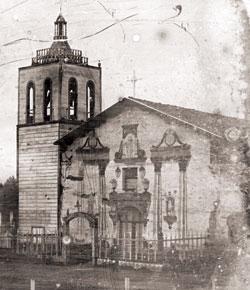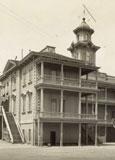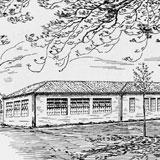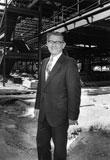Campus Changes
When work first began to turn Santa Clara mission into a learning institution, the property was simply described as "wretched." Nevertheless, Father John Nobili forged ahead and the school opened its doors in May of 1851.
Since that time, Santa Clara has changed tremendously. The first building dedicated to science was the three-story Science Building, built during the Civil War years. It contained lecture halls and laboratories, as well as a dormitory on the top floor. The building was still in use in 1911 when Professor Porta, an Italian architect who designed San Jose's Five Wounds Church, started teaching a class in civil engineering.
The College of Engineering was established in 1912 and opened with classes in the newly constructed Senior Hall (now known as O'Connor Hall) and laboratories in a former C.C. Morse & Co. seed warehouse near the railroad station.
More space for engineering students, faculty, and staff became available in 1924 with the construction of Alumni Science Hall and the Montgomery Laboratories, the first facility built specifically for engineering and named for aeronautics pioneer John J. Montgomery. Montgomery Lab was located where Mayer Theatre stands today and it utilized bricks and other materials from the razed Commercial Building. A second story was added in 1930 to be used for class and drafting rooms.
Due to high demand for engineers following WWII, the College of Engineering quickly began to expand and it was soon evident that new facilities were needed. Federal and state aid helped construct temporary buildings for additional labs and science departments, but it wasn't until the 1950s that Engineering developed plans for a true home.
In 1959, construction began on a three-unit, $1.5 million engineering center and it was dedicated in 1961. The Sullivan Engineering Complex was named after the recently retired Dean of Engineering, George L. Sullivan, while two of its buildings were named after alumni from the 1890s, George L. Turel and Dr. James D. Murphy, and the third building was named after contributor Philip L. Bannan, Sr. The buildings were devoted respectively to civil, mechanical, and electrical engineering. Reflecting the addition of the graduate engineering program, the university renamed the College of Engineering as the School of Engineering a year later.
A 1984 plan to expand engineering facilities from 45,000 to 65,000 square feet entailed several phases. The mechanical engineering building (James D. Murphy Hall) was renovated, with a second floor added to accommodate a large installation of computer workstations. The former civil engineering building was demolished, and in its place the Thomas J. Bannan Engineering Building was constructed and dedicated in 1986. The former electrical engineering building (Philip L. Bannan Hall) was transformed into a university computing center supporting institutional computing and information technology needs in 1987.
When Information Technology staff moved into the newly constructed Learning Commons in 2008, the School of Engineering returned to Philip L. Bannan Hall, renaming it the Bannan Engineering Laboratories. This 9,000 sq. ft. space allows for the expansion of innovative programs offered through the School and features numerous laboratories including three bioengineering labs, the Latimer Energy Lab, and a multipurpose laboratory.
Recently, the Department of Civil Engineering began construction on an interim high bay structural test facility which will house three actuators for testing various structural elements under earthquake, wind, and gravity loads.
One thing is certain: our second century is sure to bring even more changes to the built environment of the School of Engineering.



